Varicose Veins: What You Need to Know

In the realm of vascular diseases and disorders, varicose veins are usually on the non-threatening end of the spectrum. Most of the time these dark purple or blue veins are considered a cosmetic imperfection. Other times they cause pain and discomfort and can even be linked to more serious complications in rare cases. From causes to treatment options, here’s what you need to know about varicose veins:
1. Weak Valves are to Blame
Your veins have to work against gravity to carry blood back to your heart, so they use a series of valves to help. The valves open as the blood flows toward the heart and then close to keep it from flowing backward. Sometimes the valves are damaged or weakened and blood flows back and pools in the vein. These pools of blood cause the vein to stretch and twist over time, resulting in a varicose vein.
2. They Are Most Common in Legs
Any superficial vein in your body can become varicose. However, varicose veins are most often found in legs. This is because the vessels in your legs are under more pressure as you stand and walk upright.
3. They Can Cause Pain
A lot of times when you hear people talk about varicose veins, the concern is aesthetic. Indeed, they’re not nice to look at, and many people get treatment for cosmetic reasons. But some people experience pain due to the condition. Pain may be aching, throbbing, burning, or feel like cramping. Pain is often worse after standing or sitting for extended periods. Sometimes swelling in the lower legs will occur.
4. Certain Factors May Increase Your Risk
Factors that can increase your chances of getting varicose veins to include:
- Age
- Sex
- Family History
- Pregnancy
- Weight
- Standing or sitting for long periods
5. Spider Veins are a Mild Version
The term spider vein is used to describe veins that have become varicose, and it’s accurate. However, this term generally applies to a mild form of the condition. Spider veins are typically a cosmetic concern and do not cause pain or discomfort.
6. Serious Complications are Possible but Rare
Varicose veins are an eyesore and may cause pain, but generally, don’t cause complications. However, according to the American Society for Dermatologic Surgery, they can be linked to:
- Phlebitis, an inflamed tender vein
- Venous stasis ulcers or sores caused by fluid retention and lack of oxygen
- Thrombosis, or a clot in the vein
7. Sometimes They Don’t Need Medical Treatment
Because serious complications are rare, treatment by a medical professional is not always necessary. Pain and discomfort can be reduced with exercise and weight loss. Elevating your legs and avoiding standing or sitting for too long may also prevent veins from getting worse. Tight clothing should generally be avoided, but sometimes compression stockings are recommended to help veins and muscles keep your blood moving.
8. There are Minimally Invasive Treatment Options
If self-care practices don’t ease discomfort, there are a handful of treatment options to have the veins removed or closed. Two minimally invasive procedures that are effective at treating varicose veins are the ambulatory phlebotomy and minimally invasive vein ablation.
- Ambulatory phlebotomy: This is a minimally invasive surgical treatment in which the abnormal veins are removed through a series of tiny incisions using special tools. The procedure takes about an hour and only requires local anesthesia so recovery time is short and patients can return to regular activities quickly. This procedure is only effective for veins that are near the surface of the skin.
- Minimally invasive vein ablation: In this outpatient procedure, the doctor uses a catheter with ultrasound guidance to map out the abnormal vein’s path. An electrode is passed through the catheter to heat and cauterize the vein. As the catheter is removed, the vein collapses and seals shut. This procedure is appropriate for larger varicose veins that cause pain and inflammation.
9. You Can Take Steps to Prevent Them
You can help lower your risk of developing varicose veins by:
- Exercising
- Maintaining a healthy weight
- Eating a diet high in fiber and low in salt
- Changing sitting and standing positions frequently
- Elevating your legs
- Avoiding high heels
At Preferred Vascular Group, our physicians specialize in vascular treatments that are patient-focused and deliver fantastic results. Our services include varicose vein treatments like ambulatory phlebotomy and minimally invasive vein ablation.
—
If you would like to schedule an appointment at Preferred Vascular Group to have a consult with a Board-Certified physician or would like to have one of our highly trained care providers reach out to you, please click on a button below:
